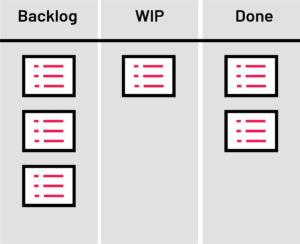Using Kanban for Flow in Non-tech Teams
While Lean Manufacturing and Agile software development are well established worldwide, the most successful companies are now recognizing that Lean/Agile principles can be applied to every aspect of the business. From Marketing to HR to Finance and beyond, all business units can learn to deliver more value more efficiently in alignment with the rest of the organization.
In this article, we’ll briefly discuss some of the principles behind one Lean/Agile methodology — Kanban — and how they can be applied to the work done in these non-technical areas of the business.
Using Kanban to support workflow

Kanban basics
The basic concepts behind Kanban are simple:
- Visual – A Kanban system is highly visual, often relying on a physical or electronic “kanban board” on which an item’s (or task’s) status is clearly defined. This promotes transparency and collaboration.
- Pull-based – Rather than physical products or tasks being “pushed” along the system and building up at a point where progress slows, work is instead “pulled” to the next step only when there is the capacity to work on it (i.e. work-in-progress (WIP) limits). This promotes efficiency and quality, reduces waste, and spotlights inefficiencies in the system itself.
- Clearly defined – Each step in a Kanban workflow relies on thorough, agreed-upon definitions of when a task or item is “ready” to enter a given step and when it is “done” and able to move on. These definitions provide the basis of the “total quality management” system the Toyota factories became famous for.
Kanban systems promote quality, efficiency, and continuous improvement. The point is not just to get the job done, but to do so in the best way possible with the highest quality output as defined by the end user.
Kanban and Agile
It’s easy to see how and why the principles of Kanban translate so well into Agile software development. Rather than steps in the manufacturing process, the developer’s Kanban board might include columns for Backlog, Development, Testing, Deployment, and Release. User stories and epics travel through that workflow, following established WIP limits and policies (the agreed-upon definitions around acceptable work).
Kanban principles work hand-in-hand with Agile principles, which also prioritize visibility, efficiency, value delivery, and continuous improvement through iterative work and feedback loops. Agile’s user stories, the definition of ready, and the definition of done all align well with the policies inherent in a Kanban system. And, WIP limits provide valuable control that a cross-functional Agile team can use to keep tasks moving forward optimally.
When combined with a specialized Agile process like Scrum, a Kanban system can support even a large and complex development organization.
Kanban for Agile business teams

In fact, the most basic Kanban workflow — To Do, Doing, Done — can be implemented in literally any team in any organization. And, even at the simplest level, it can bring benefits almost immediately. When combined with WIP limits and function-specific policies at the team level, a simple Kanban system can transform how a non-tech team operates.
Check out some sample Kanban workflows for Marketing, HR, and Finance teams.
Keys for Agile business teams using Kanban
To make a simple Kanban system Agile, three points must be considered:
1. The backlog is not just a pile of work
Non-agile teams tend to work on whichever tasks seem to be most urgent, or that come from whoever screams the loudest. A Kanban system may help these teams accomplish the wrong thing quickly and efficiently, but that’s not true Agility. There must be a mechanism in place to groom and prioritize items in the backlog so that every time a new item is pulled into the system, it’s the right thing for the team to be working on at that time.
2. You can’t be truly Agile in a silo
While there are benefits to operating with Kanban strictly at the team level, much of the benefits can be stripped away at the points in the system where the team depends on — or is depended upon by — other teams and business units. The goal should be to align the team’s Agile processes with other teams in the organization as soon as possible, effectively “joining the value stream” wherever possible.
3. Continuous improvement doesn’t happen automatically
Scrum has a specific set of ceremonies and artifacts designed to formalize the process of continuous improvement. Kanban alone does not. However, if there is no mechanism in place to routinely review the system itself as well as the quality of the output it produces, one of the most valuable benefits of Agility can be lost.
That’s why mature organizations often end up with some sort of hybrid system like Scrumban that melds the power of both methodologies. Of course, every team and organization is different, and Kanban can be molded to fit them all. To speak to a Kanban expert about your unique situation, contact us.



